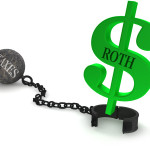 As tax returns come due each year, many people use that time as an opportunity to analyze their finances and determine if their financial strategies are still efficient. One of the more common ways of reducing your current tax liability is to take advantage of
As tax returns come due each year, many people use that time as an opportunity to analyze their finances and determine if their financial strategies are still efficient. One of the more common ways of reducing your current tax liability is to take advantage of
certain retirement plans, such as a 401(k) or Traditional IRA. These are tax-deferred plans, which can allow for a reduction of your current taxable income. These, however, simply defer taxes to a later point in time when you retire and begin withdrawing funds from the account.
Roth IRA accounts were established by the Taxpayer Relief Act of 1997 and offer tax-exempt retirement savings. For 2014, the maximum contribution that can be made to a Roth IRA is $5,500. Unlike tax-deferred accounts, there is no immediate tax benefit such as a tax deduction. The real benefit comes during retirement when you may withdraw funds from your Roth IRA completely tax free. With that said, there are limitations on who is eligible to contribute to Roth IRA accounts. For example, couples with a combined annual income of $191,000 or more cannot contribute to a Roth IRA. For single tax filers, the annual income limitation is set at $129,000 or more. However, since 2010, Congress has allowed high-income earners a way to enjoy the benefits of a Roth IRA.
Roth Conversions
The first thing to understand is the difference between a contribution and a conversion. A contribution is when you contribute or deposit new funds into an account. As noted above, there are income limitations for who can contribute to a Roth IRA. A conversion can occur when you move funds from a Traditional IRA into a Roth IRA. Since 2010, anybody can convert Traditional IRA funds to a Roth IRA regardless of income. This allows for a strategy that has been described as a backdoor Roth IRA.
The first step is to set up a Traditional IRA. Since high-income earners cannot contribute directly to a Roth IRA, you would make a non-deductible contribution to the Traditional IRA instead. After the funds have been posted and settled into the account, you can submit a request to your IRA custodian to have these funds converted to your Roth IRA.
Since the initial contribution to the Traditional IRA was non-deductible, you have essentially already paid the taxes. When you convert the funds, you will only need to pay taxes on the converted amount exceeding the original non-deductible contribution. If the funds were only held in cash within your Traditional IRA for a short period of time prior to converting, then the taxes will likely be minimal.

*The above image is for illustrative purposes only. Do not attempt a Roth conversion without speaking to a tax advisor.
Pro-Rata Rule
One thing that needs to be considered before making a conversion is the pro-rata rule. When calculating the taxable income from a Roth conversion, this rule stipulates that you cannot convert just the non-deductible contribution and must include all non-Roth IRA accounts that you own (including SIMPLE and SEP IRAs). A potential way of avoiding the pro-rata rule is to roll over your pre-tax IRA dollars into your employer’s 401(k). In order to calculate the amount of a Roth conversion that is not taxed, you would divide the total non-deductible, or after-tax, contributions by the total balance across all of your IRA accounts (excluding Roth IRAs). As a result of the pro-rata rule, those who have existing IRAs with deductible contributions may find themselves owing a lot in taxes after a Roth conversion.
Are Roth Conversions Right for Me?
Determining whether or not a Roth conversion makes sense is something that needs to be analyzed on a case-by-case basis. When making these conversions, it is best to pay any taxes owed out of pocket instead of using IRA funds. If you do not have enough money to pay the taxes out of pocket, then a conversion would probably not be an appropriate recommendation. For high-income physicians who do not have any other pre-tax IRAs, then a backdoor Roth IRA may be a great option for accumulating future tax-free retirement savings. For any financial strategies with potential tax implications, you should always seek the advice and counsel from a tax professional before taking any action.
Disclaimer: Advisory services are offered through Rivetti Investment Services, LLC, a Registered Investment Adviser. Neither Rivetti Investment Services, LLC nor Rivetti Financial Group, LLC provides tax advice or recommendations. This article should not be construed as tax advice. You should consult with a tax professional before taking any action. The information is believe to be current at the time this article was written and is subject to change without notice.
